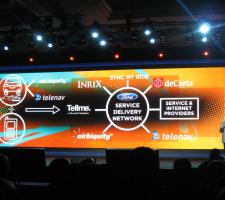
Next-generation vehicle cockpit concept from Visteon; the distinction between conventional instrument cluster and centre-stack displays is becoming increasingly blurred
This year's Consumer Electronics Show in Las Vegas was characterised by consumer telematics solutions, writes Dave McNamara
Consumer telematics characterised this year's Consumer Electronics Show, which took place 8-11 January in Las Vegas, in that a significant number of exhibits were focused on technologies specific to the automobile and Location-Based Services (LBS). Significantly, the cell phone was adopted by
Overall, the event reinforced that the CE industry will drive automotive electronics, as built-in is supplanted by 'beamed-in' (via wireless or telematics) and 'brought-in' (via smart phones).
On the first day of the show, Ford CEO Alan Mulally announced the third generation of Ford SYNC, a factory-installed in-car communications and entertainment system developed in conjunction with Microsoft. Ford is firmly committed to the cell phone as the communication device versus an embedded solution (as typified by the OnStar system developed by GM and now adopted and enhanced by
Both Mullally and Derrick Kuzak, Ford's North American Product Development Vice President, made a point of recognising a plethora of Ford "technology experts" or business/technical partners. This underlined that the automotive industry is more than ready to work with the CE and telecommunications industries.
Ford thinks that its strategy will make it faster to market with new features, provide a saleable platform for broad deployment across its fleet and, lastly, be more affordable and available to the masses. For example, Mulally announced a new service delivery network based on a voice interface (TellMe) to services for traffic (
The SYNC MyRide Website allows personalisation of addresses for the navigation service and a set of application programming interfaces for plug-and-play services over the internet. The software for 2010 SYNC systems can be upgraded by downloading the firmware to a USB flash drive then loading it to the car via a USB port.
SYNC will be global starting in 2010, first in Europe with seven Western European languages and then two Eastern European countries. Asia and Australia will follow.
Device of choice
The 3G smart phone has emerged as the personal device of choice for LBS. The current device platforms and related support/delivery systems are the:PND/cell phone convergence
Many think the PND and cell phone will converge into one device. Some smart phones have begun offering navigation applications and some PND manufacturers have stopped producing navigation devices. But a number of changes have taken place in the market in the past year to make a PND a companion to the phone. The connected PND is here and there were some interesting offerings on show from Mio, Magellan and Navigon.The
Automotive industry participation
The vehicle cabin is becoming more PC-like, except for the user display which is highly stylised with the appropriate placement of large-panel displays and controls. The distinction between cluster and centre-stack is becoming blurred and a seamless cockpit is the result. The computing platform is also highly integrated versus multiple microprocessors dedicated to each display. This architecture makes the addition of new telematics features, such as dynamic navigation, 3D navigation and other new mobility features (curve speed warning, eco-friendly routing and so on) easy and affordable to integrate.Bosch presented a variety of technologies, including a curve-speed warning system, dual-view displays, night vision and a couple of impressive instrument cluster solutions that use large, reconfigurable LCD displays. The instrument clusters are examples of the growing trend toward flexible, reconfigurable solutions.
One of Bosch's most interesting exhibits was a dual-view display implemented in a vehicle centre-stack. Such displays offer many opportunities for infotainment features to front-seat passengers while only allowing drivers to see the screens that are appropriate. These displays also enable OEMs to implement one rear-seat display while allowing rear-seat passengers to view two different streams of video.
Together with its partner 3M, Visteon showcased the next generation of cockpits. The Integrated Control Panel (ICP), a 2011 concept, features: multiple large-panel LCDs with highly integrated content which blur the distinction between a conventional instrument cluster and centre-stack displays; and 3D displays for dynamic navigation. The latter was produced with partners Planet9 and NDVIA.
The Toyota NA system is an improvement to the existing OnStar product and has a similar overall architecture based on an embedded cellular radio as part of a telematics control unit, Telematics Service Provider (TSP) and customer-facing Web portal. At the Telematics Update Consumer Telematics Show, held the day prior to CES, Toyota confirmed ATX as its TSP. The Cross Country/ATX approach is to be agnostic relative to the wireless solution and the in-vehicle hardware and focus on innovative off-board services.
Jon Bucci, Toyota's Vice President of Advanced Technology, gave an outstanding presentation at the Telematics Update CTS. He described Toyota's thoughtful and methodical approach to balance consumer wants/needs, development timelines and cost. Bucci emphasises a process focused on executing a set of features that would meet customer and business needs while understanding that no one size fits all.
Hughes Telematics
Hughes Telematics made several key announcements: in-Drive, an aftermarket product line offering telematics services and hardware; Cocero, a white-label brand which partners can adopt under their own brand; and adoption of the Next Generation Telematics Protocol (NGTP).Contrasting with the Cross Country/ATX approach, NGTP is an open architecture solution to support various vehicle interfaces and data formats.
Lastly, the 2010
Content providers
The selection of Inrix by Ford SYNC was a significant development in the traffic content providers war between Inrix and Traffic.com (Navteq continued to promote the Navteq LocationPointTM Advertising LBS. This is an approach for subsidising high-value content services, while enabling advertisers to reach and engage with consumers where and when they are making shopping and purchasing decisions.













